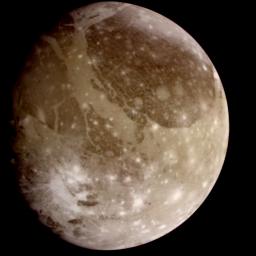
Contact: Guy Webster (818) 354-6278
FOR IMMEDIATE RELEASE
December 16, 2000
A thick layer of melted, salty water somewhere beneath Ganymede's icy crust would be the best way to explain some of the magnetic readings taken by NASA's Galileo spacecraft during close approaches to Ganymede in May 2000 and earlier, according to one new report.
In addition, the types of minerals on parts of Ganymede's surface suggest that, in the past, salty water may have emerged from below or melted at the surface, according to a study of infrared reflectance measured by Galileo.
Third, new Galileo images of Ganymede hint how the water or slushy ice may have surfaced through the fractured crust, reminiscent of linear features on Europa, a neighboring moon believed likely to have a deep ocean beneath its ice.
Several of the new images, prepared by researchers at Brown University, Providence, R.I., and the German Aerospace Center (DLR), Berlin, Germany, are available from NASA's Jet Propulsion Laboratory, Pasadena, Calif., at http://www.jpl.nasa.gov/pictures/jovianmoons.
They include the most detailed photos ever taken of Ganymede and an animated virtual flyover of an area where a smooth, bright swath resembling parts of Europa cuts across older, more heavily cratered terrain.
The new information about Ganymede is being presented at the fall meeting of the American Geophysical Union, beginning today (Dec. 15) in San Francisco. Ganymede is the biggest moon in the solar system and bigger than the planets Mercury and Pluto. It was named for a boy in Greek mythology who was so beautiful that Jupiter, king of the gods, had him brought to Olympus by an eagle.
The magnetic clues to a possible saltwater layer at Ganymede are more complicated than earlier magnetic evidence of hidden oceans on two other moons of Jupiter, Europa and Callisto, said Dr. Margaret Kivelson, a planetary scientist at the University of California, Los Angeles, and principal investigator for Galileo's magnetometer instrument. That's because Ganymede has a strong magnetic field of its own, instead of just a secondary field induced by Jupiter's magnetism.
But the indications of an induced field at Ganymede are "highly suggestive" of a salty ocean on Ganymede, too, Kivelson said. "It would need to be something more electrically conductive than solid ice," she said.
A melted layer several kilometers or miles thick, beginning within 200 kilometers (120 miles) of Ganymede's surface would fit the data if it were about as salty as Earth's oceans, Kivelson said.
Ganymede is covered with lots of ice and frost, both in the older, dark terrains and younger, bright terrains, said Dr. Thomas McCord, a geophysicist at the University of Hawaii, Honolulu, who has been using Galileo's infrared spectrometer instrument to identify surface materials on Ganymede. Portions of the moon appear to have types of salt minerals that would have been left behind by exposure of salty water near or onto the surface, he said.
"They are similar to the hydrated salt minerals we see on Europa, possibly the result of brine making its way to the surface by eruptions or through cracks," McCord said. The infrared evidence does not indicate whether or not an ocean persists at Ganymede today, he said.
Photos Galileo took as it passed within 809 kilometers (503 miles) of Ganymede on May 20 display details of a tumultuous past, according to Drs. James Head III and Robert Pappalardo, planetary scientists at Brown.
"Bright broken swaths, disrupted dark plains and the astounding Arbela Sulcus suggest Ganymede may be more similar to Europa than previously believed," Pappalardo said. Arbela Sulcus is a relatively smooth, bright band interrupting a more cratered, older landscape. The new images show subtle striations along its length. "It is possible that Arbela Sulcus has formed by complete separation of Ganymede's icy crust, like bands on Europa, but unusual for Ganymede," he said.
Natural radioactivity in Ganymede's rocky interior should provide enough heating to maintain a stable layer of liquid water between two layers of ice, about 150 to 200 kilometers (90 to 120 miles) below the surface, said Dr. Dave Stevenson, planetary scientist at the California Institute of Technology, Pasadena. That's a difference from Europa, where interior flexing from tidal effects of Jupiter's gravity provides much of the internal heat, he said.
"I would have been surprised if Ganymede had not had an ocean, but the issue of whether it's there is different than the issue of whether you can expect to see it clearly in the data," Stevenson said.
Galileo has been orbiting Jupiter since Dec. 7, 1995. It will fly past Ganymede again on Dec. 28, but will not come as close as it did in May. Additional information on Galileo is available at http://galileo.jpl.nasa.gov. The Galileo mission is managed for NASA's Office of Space Science, Washington, D.C. by JPL, a division of the California Institute of Technology.